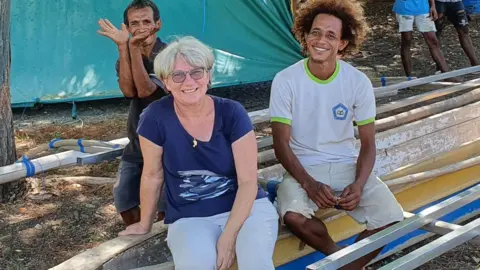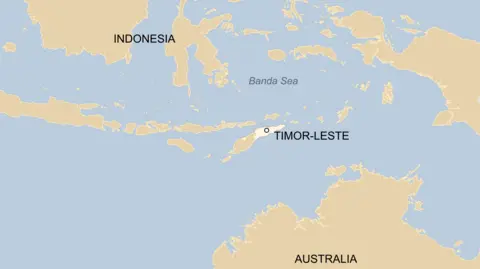How citizen scientists are uncovering the secret lives of blue whales

For about two months each year, fisherman Faustino Mauloco da Cunha and his son Zacarias spend most of their days in a dugout canoe at sea in the South Pacific Ocean.
Equipped with binoculars and a telephoto camera, they scour the cobalt waters for one of its great treasures – the pygmy blue whale.
When there is a vision all systems go into action.
A team based in da Cunha’s village – called Subaun – sends a drone. Then the team leader, Australian marine ecologist Karen Edwin, guides the drone operator to take the best photos. When the drone returns, the team reviews the photos and takes notes on a white board.
It is a small and frugal operation in Timor-Leste, part of an archipelago located between Southeast Asia and the South Pacific. But it has generated abundant information about pygmy blue whales – one of the largest animals on Earth, whose vast habitat and elusive nature makes them challenging to study.
These citizen researchers, all of whom are local, have seen approximately 3,000 pygmy blue whales over the past 10 years – Professor Adiwen considers this a “truly extraordinary” number.
 mario cabral
mario cabralTimor-Leste has the highest concentration of marine mammals in the world.
During migration season – October and November – hundreds of pygmy blue whales pass through the country’s waters as they make the thousands of kilometers of journey from southern Australia to the Banda Sea, north of Timor-Leste.
But the area has been under-researched, says Professor Adiwen, who started the monitoring program in 2014.
During whale season over the past decade, he based himself in Subaun, about 50 km (31 mi) from the capital Dili, working with fishermen, students and dive tour operators to document the cetaceans.
“They have documented some of the lesser-known, intimate breeding behaviors of blue whales, some for the first time,” says Professor Edwin, who lectures at the Australian National University and Charles Darwin University.
For example, in July, the team captured underwater footage of a mother nursing her calf, offering a glimpse into the species’ reproductive behavior, which is largely unknown.
“It’s very, very exciting,” she adds.

 Zacarias da Cunha
Zacarias da CunhaThe project began as a Facebook group, inviting local volunteers to explore and document the lives of pygmy blue whales.
Professor Adiwen trained them on survey methods and hired professionals to teach them how to use telephoto cameras and drones so they could conduct aerial and boat surveys.
“When local people living along the coast see whales swimming, they will post pictures on Facebook and WhatsApp. Updates come on a real-time basis and when someone shares something, everyone gets very excited,” says Professor Adywen.
In 2016, the team worked with a dive tour operator to launch the first whale-watching tours.
Just last year he set up a “research station” outside da Cunha’s village home – photos show a simple hut overlooking the bay. Outside, there are two tables, plastic chairs and white boards on the walls of the hut.
 karen ediven
karen edivenDuring this year’s whale season, graduate students from the National University of East Timor gathered at the research station to help with sightings.
Such infrastructure has also made the work easier.
“We are able to monitor all day and all night,” says Professor Adiwen. “We are able to get the most incredible footage too. Sometimes the whales come so close that we can actually hear them blow.”
Wildlife scientist Vanessa Pirotta says citizen researchers like these have become powerful eyes and ears for marine scientists on land.
“The combination of people having access to tools like drones and social media means we have insight into things that are happening while we’re behind the desk writing grants for our work,” he said.
The increase in research activity in Subaun has also led to an increase in tourism.
Dive instructor Cassio Schumacher told the BBC that demand for whale-watching tours has increased, adding that these tours are “booked years in advance”.
Local non-profits have warned about the dangers of unregulated whale tourism and the government has said it will use Professor Adiwen’s research to “fully preserve and protect” the marine life that passes through Timor-Leste’s waters. Intends to use.
 karen ediven
karen edivenProfessor Adiwen believes that with regulation, whale tourism has the potential to create jobs and enhance the economy of Timor-Leste.
According to the International Monetary Fund, the country is one of the poorest in the world, with the average annual income in cities hovering around $1,500. In Subaun, most rural livelihoods work as fishermen and farmers, earning only $600 to $900 per year.
The da Cunha family has now started preparing meals from local produce and catering day-long meals for students and tourists – an additional source of income.
“We enjoyed being with the guests and would love to do it again,” Faustino, 51, told the BBC over a WhatsApp video call. “We will make it a better experience (next season).”
His son Zacharias has also been contracted to provide drone services for the project. Professor Adiwen says she plans to train them to converse in English about whales.
The 26-year-old man says he appreciates that visitors are learning to protect the area: “University students learn to protect the area fast and well.”
As far as tourists are concerned, they say that the local people are happy to teach them. “We remind tourists not to swim with the whales, but to observe them from a distance.”






